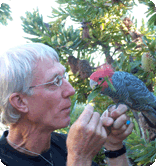Mystery death in mixed aviary

I found Sid elderly wild-caught and rescued Timneh African Grey parrot, dead in the nest box where he sleeps. Sid could not fly. HE has shared since last September the shed in which the nest box is placed with Vernon 6 year old Timneh cock. In the aviary are a pair of Amazons in a separate flight, one Timneh hen and 11 parakeets.
His head was gnawed on one side eye and his brain eaten and his windpipe exposed. I suspected a rat. After 2 and a half hours searching the perimeter of the aviary which consistes of 4 X 25 foot sections and 20 foot broad, we have found no holes nor are there any gaps visible in the roof wire. WE have had a recent infestation of field mice which has been controlled with poison in small bait boxes.
Since Sid’s death 5 days ago I have put down 4 lots of rat poison but it has not been touched. The pest control officer visited today. I was disappointed that, like us, he could find no evidence of rats. He suggested a stoat or a weasel. There is a chicken house in the aviary with a dozen hens. They are untouched.
As he found no evidence of rat holes he put down no bait. He suggested that Vernon, Sid’s companion had done this. I have had parakeets attack weak ones. And a Timneh has killed a weak Alexandrine hen. They have never eaten the corpse.
Sid was ailing. He was definately killed at night as I saw him alive at dusk. Vernon had no blood on his feathers and did not eat for a day or so. Has anyone any ideas or solutions? I am totally at a loss of what to do.
Dot

Dear Dot,
Not only is this a complex question, but ‘tis one which I find quite difficult to answer from afar. Predators and rodent infestations in an outdoor aviary usually are best solved in situ where one can observe and deduce properly.
That said I have several conclusions about your state.
Normally it is best to have a post mortem on parrot mortalities where one is unsure if the bird was injured/killled by another occupant in the aviary. This is not always conclusive but may shed light on whether the psittacine died and then was chewed and mutilated by other avian occupants of the cage. Cause of death is why we call in an avian vet…
I have spent two plus decades of avicultural work with differing African species and never received input to the supposition that two male grey parrots in a large enclosure would fight to the death over one issue or another (no female being involved). I think you can rule that out…
The circumstances you describe indicate to me that Sid was obviously partially eaten by a carnivore/omnivore. The eating of the brain cavity is consistent with killing animals that are not overtly hungry but choose the gourmet portion of the animal they killed or they found freshly dead. Certainly weasels and stoats and mongoose and mink and such all fit into this category. Well fed varmints I suggest….
The rodent problem you acknowledge is probably not limited to mice. Large mice make their way into an aviary, and are followed in scent and tunnel by small rats which are in turn followed by larger rats that expand entrances minimally to allow passage. Furthermore, the photos you provided WPT about your aviary show that some wire walls are of hardware chicken wire and other openings have been stretched and expaned by beaks—even the smallest of these openings in the wire are sufficient to allow a rat entrance to the flight. Anywhere a rat can insert its head when hungry, it can enter by squeezing its body——one inch round wire openings are excellent for entrance.
Now I have not known rats to eat the brain of a victim. The ones I have experienced were more likely to chew the toes and eyes and extremeties of a bird. But overnight who knows what might happen if rats entered your flight where a grey parrot had died.
A flighted Grey parrot attacked by a predator such as a stoat or a weasel will usually put up a brief fight.. That means clumps of feathers and evidence of plumage disarray on the ground the next day or in the nestbox at night. The same with rats.
You did not say what kinds of parakeets so I am assuming Budgerigars. They are unlikely to chew a brain or windpipe. You also did not say whether the amazon parrots in the flight ever tried to usurp the nestbox. Keeping box sleeping species in an aviary along with the box—-with Amazons or other nesting parrots when the days begin to lengthen and rains commence towards breeding is not a good idea.
On the other hand, normally rats in and around a flight will at least sample baits put out for control, so that indicates a larger predator.
Rats leave droppings which can be smelled and can be located around food areas. A rat does not kill a Grey; it may bite and bleed them, but it cannot take them down one on one unless the bird is weak and dying.
As for recommendations. I would say it is time to upgrade the wire and structure of your adoption facility. I personally doubt that a Timneh killed a weak Alexandrine unless there were a nestbox or a food station involved, but that and this recent death should be indicators of something amiss at the site. Having a chicken coop in a parrot aviary is old fashioned and inappropriate…it also leads to pests.
The statement “Sid was ailing” leaves a lot to be interpreted. Perhaps he should have been in special care or at least isolated during the “ailing.”
I am sorry for your loss and your consternation. April and I shall light a candle this week in memory.
Aloha, EB and April

































